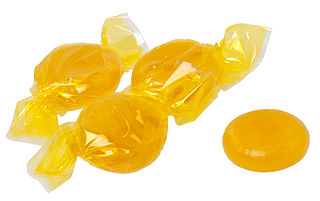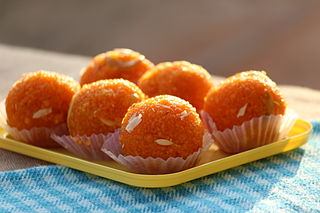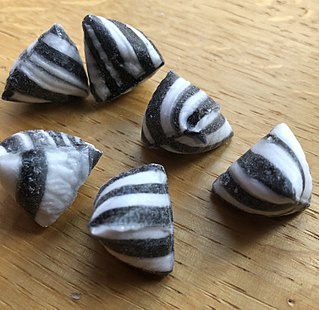
Liquorice or licorice is the common name of Glycyrrhiza glabra, a flowering plant of the bean family Fabaceae, from the root of which a sweet, aromatic flavouring is extracted.

Spangles was a brand of boiled sweets manufactured by Mars Ltd in the United Kingdom from 1950 to the early 1980s. They were sold in a paper packet with individual sweets originally unwrapped but later cellophane wrapped. They were distinguished by their shape which was a rounded square with a circular depression on each face.

Butterscotch is a type of confectionery whose primary ingredients are brown sugar and butter. Some recipes include corn syrup, cream, vanilla, and salt. The earliest known recipes, in mid-19th century Yorkshire, used treacle (molasses) in place of, or in addition to, sugar.

Liquorice allsorts are assorted liquorice confectionery sold as a mixture. Made of liquorice, sugar, coconut, aniseed jelly, fruit flavourings, and gelatine, they were first produced in Sheffield, England, by Geo. Bassett & Co Ltd.

London drops are a type of liquorice candy sold in Finland and Sweden first by Chymos, later by Fazer.

Laddu or laddoo is a spherical sweet from the Indian subcontinent made of various ingredients and sugar syrup or jaggery. It has been described as "perhaps the most universal and ancient of Indian sweets."

Rasgulla is a syrupy dessert popular in the eastern part of South Asia. It is made from ball-shaped dumplings of chhena dough, cooked in light sugar syrup. This is done until the syrup permeates the dumplings.
A limpet mine is a type of naval mine attached to a target by magnets. It is so named because of its superficial similarity to the shape of the limpet, a type of sea snail that clings tightly to rocks or other hard surfaces.

Parma Violets are a British violet-flavoured tablet confectionery manufactured by the Derbyshire company Swizzels Matlow, named after the Parma violet variety of the flower. The sweets are hard, biconcave disc-shaped sweets, similar to the Fizzers product from the same company but without their fizziness. Swizzels Matlow have also released a line of Giant Parma Violets.
Mithai (sweets) are the confectionery and desserts of the Indian subcontinent. Thousands of dedicated shops in India, Bangladesh, Nepal, Pakistan and Sri Lanka sell nothing but sweets.

A buñuelo (Spanish:[buˈɲwelo], alternatively called boñuelo, bimuelo, birmuelo, bermuelo, bumuelo, burmuelo, or bonuelo, is a fried dough fritter found in Spain, Latin America, and other regions with a historical connection to Spaniards, including Southwest Europe, the Balkans, Anatolia, and other parts of Asia and North Africa. Buñuelos are traditionally prepared at Christmas. It will usually have a filling or a topping. In Mexican cuisine, it is often served with a syrup made with piloncillo.

Khoa, khoya, khowa or mawa is a dairy food widely used in the cuisines of the Indian subcontinent, encompassing India, Nepal, Bangladesh and Pakistan. It is made of either dried whole milk or milk thickened by heating in an open iron pan. It is lower in moisture than typical fresh cheeses such as ricotta. It is made up of whole milk instead of whey. Palakova, a delectable Indian sweet, holds a cherished place in the hearts and palates of connoisseurs of Indian cuisine. With its rich history, exquisite taste, and cultural significance, Palakova captivates food enthusiasts worldwide.

Humbugs are a traditional hard-boiled sweet available in the United Kingdom, Ireland, South Africa, Canada, Australia and New Zealand. They are usually flavoured with peppermint and striped in two different colours. In Australia, the black-and-white-striped humbugs are flavoured aniseed and sold at all major supermarkets. Humbugs may be cylinders with rounded ends wrapped in a twist of cellophane, or more traditionally tetrahedral formed from pinched cylinders with a 90-degree turn between one end and the other loose in a bag. Records of humbugs exist from as early as the 1820s, and they are referred to in the 1863 book Sylvia's Lovers as being a food from the North.
Bhojpuri cuisine is a style of food preparation common among the Bhojpuri people of Bihar and eastern Uttar Pradesh in India, and also the Terai region of Nepal. Bhojpuri foods are mostly mild and tend to be less hot in terms of spices used. The cuisine consists of both vegetable and meat dishes.
Colonel Robert Stuart Macrae TD was an inventor best known for his work at MD1 during the Second World War, his best known invention being the sticky bomb.

Sherbet is a fizzy, sweet powder, usually eaten by dipping a lollipop or liquorice, using a small spoon, or licking it from a finger.
Ministry of Defence 1 (MD1), also known as "Churchill's Toyshop", was a British weapon research and development organisation of the Second World War.

Vichy Pastilles, less often pastilles of Vichy, are a French confectionery invented in 1825 and produced in the spa town of Vichy in central France. They are recognizable as a white, octagonal type of candy pastille bearing the word "Vichy" in all-caps.
Major Cecil Vandepeer Clarke MC (1897–1961) was an engineer, inventor and soldier who served in both the First and Second World Wars.













